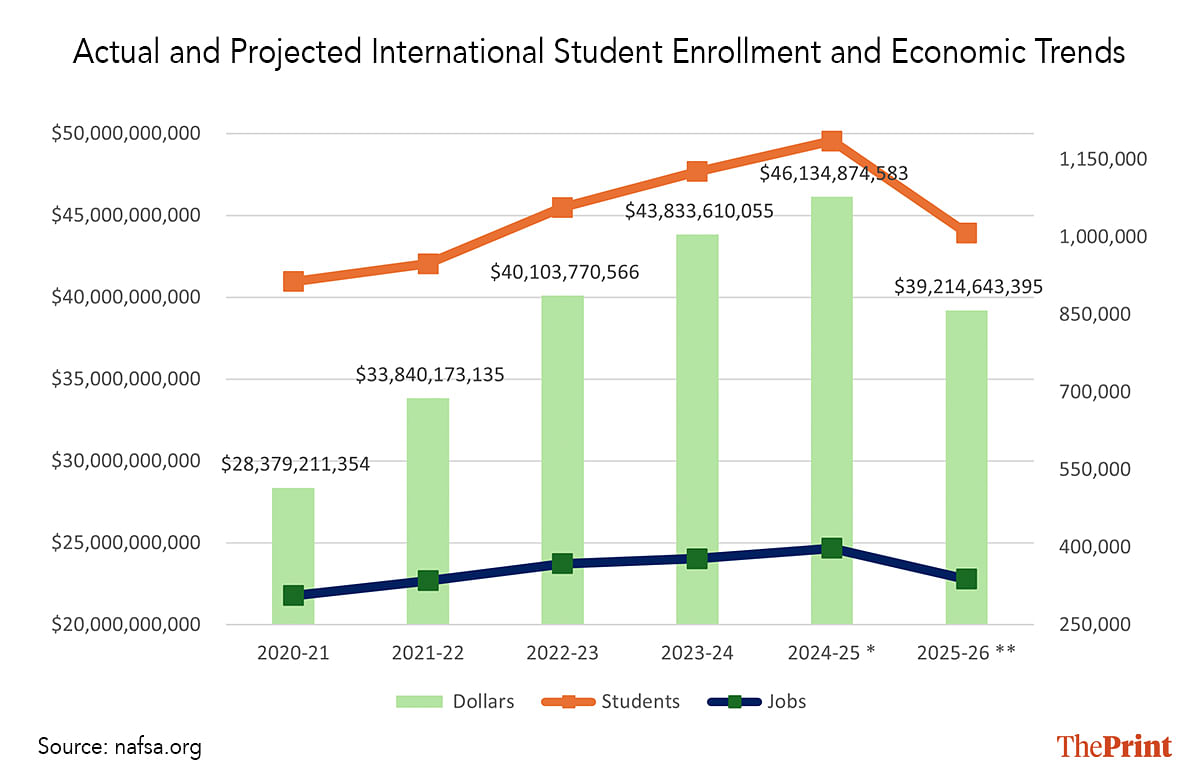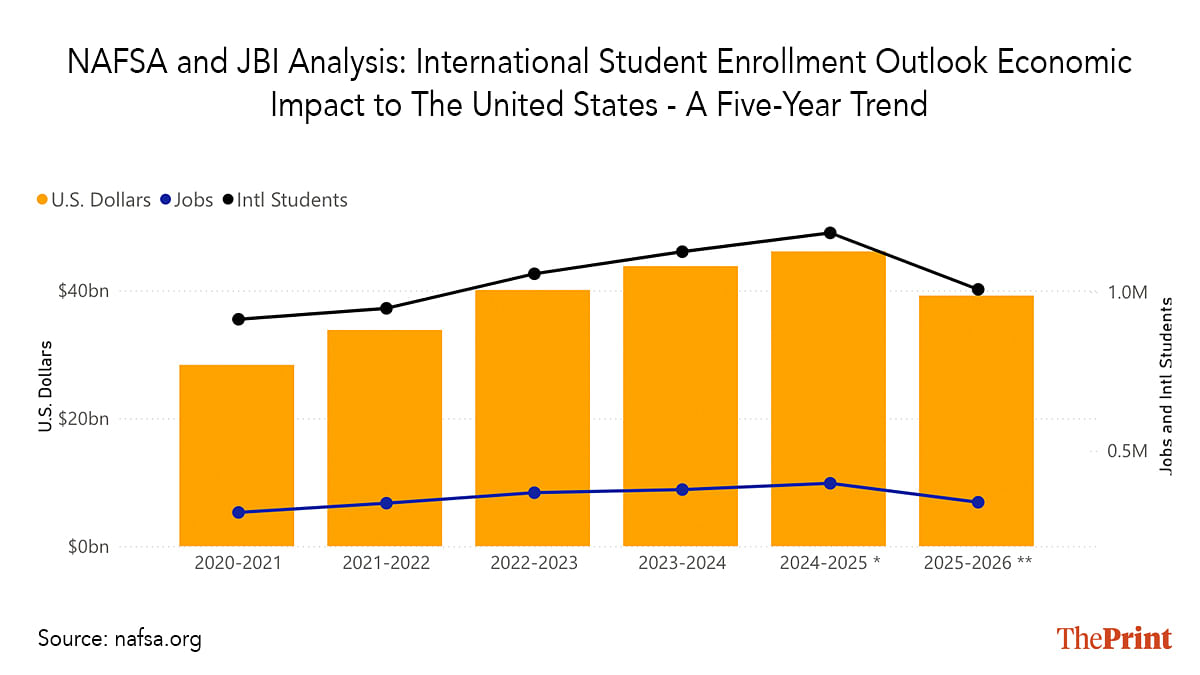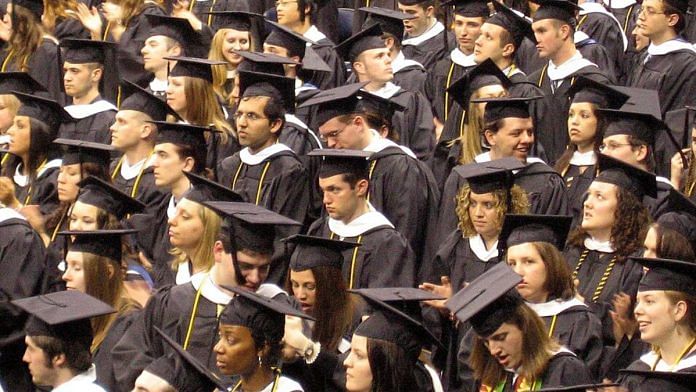New Delhi: The United States is likely to receive at least 1,50,000 fewer international students this year due to ongoing uncertainties over US visas, with the fallout being 60,000 fewer jobs and a $7 billion revenue loss, according to the preliminary projections by NAFSA: Association of International Educators.
A report by JB International, analysing the student & exchange visitor information system (SEVIS) as well as the US state department data, estimates a 30–40 percent decline in new international student enrolment this Fall, potentially leading to a 15 percent drop in yearly enrolment.
These studies follow the Trump administration’s implementation of a series of crackdowns on international visa holders, as well as the introduction of stricter policies and expanded travel restrictions, affecting students and exchange visitors.
The report highlights limited or zero appointments for US visas at American consulates in India, China, Nigeria, and Japan by students from those respective nations. Among countries from which international students arrive in the US, India and China are the top two, whereas Nigeria ranks seventh and Japan 13th.

The Open Doors Report 2024 confirms 3,31,602 Indian students across US institutes in the 2023-24 academic year, making India the largest source of international students. Indians accounted for 29.4 percent of the total 11,26,690 international students in the US.
The latest available US state department data for the February-May period shows Indian students so far received 10,496 F-1 visas for academic purposes—fewer than the 14,068 F-1 visas issued over the same period last year. Indian students who, so far this year, have obtained their US visas are 25.4 percent fewer than those who received visas between February and May last year.
Sakshi Mittal, the founder of education consultancy University Leap, said her consultancy is witnessing firsthand how visa delays, reduced appointment slots, and shifting policies are putting aspirations of studying in the US at risk.
“We have had students admitted into Ivy League universities but still waiting for visa appointments,” she said. “Most universities are not deferring their offers. Students have already rejected offers from top institutions in other countries. They never anticipated the situation would reach this level.”

Also Read: ‘Honest history, not ideology’—NCERT social science panel chief on changes in Class 8 textbook
Reasons behind the drop
The NAFSA projection report states that during the peak visa issuance period—27 May to 18 June—this year, student visa interviews were on pause, affecting those who aimed to enrol in one or the other institute this Fall. In the first four months of this year, newly issued F-1 visas dropped 12 percent. Nearly 22 percent fewer F-1 visas have been issued up to May this year compared to last year.
“June 2025 F-1 issuance data has not yet been published, but a decrease of 80–90 percent is possible based on the factors identified here,” the report adds.
It further cites “visa bans” as the key reason for the decline in visas issued. “Restrictions targeting 19 countries, as per a 4 June 2025, executive order—with another 36 countries rumoured to be added— threaten $3 billion in annual contributions and over 25,000 American jobs,” the report states.
Looking ahead to next year’s intake, Sakshi Mittal noted growing hesitation among parents and students regarding US education. “I already see families not wanting to opt for the US, given the uncertainty—not only around visas but also the pressure from the Trump administration to restrict the number of international students. They now prefer alternative destinations,” she said.
“Countries like the UK, Germany, France, and Dubai are gaining momentum. Australia and New Zealand are also introducing positive policies to attract more international students. So, we may see a noticeable shift,” Mittal said.
“While interest in the US remains high, the current sentiment and policies could make it increasingly difficult unless positive reforms are implemented,” she added.
Economic Impact
According to the NAFSA projection, the drop will also cause a massive economic impact. It states there will be a loss of up to 7 billion US Dollars.
The state hosting the most international students, California, alone, is projected to lose over $1 billion in revenue. Similarly, New York may witness a revenue loss of $980 million. Texas is likely to bear an approximate loss of $388 million.
Fanta Aw, executive director and CEO of NAFSA, said the immediate economic losses projected are just the “tip of the iceberg”.
“International students drive innovation, advance America’s global competitiveness, and create research and academic opportunities in our local colleges that will benefit our country for generations. For the United States to succeed in the global economy, we must keep our doors open to students from around the world,” she said.
To mitigate the potentially devastating impact on cities, towns, and educational institutions, NAFSA has urged the US state department to provide expedited visa appointments and process all F-1 and M-1 visas for students, as well as all J-1 visas for exchange visitor applicants.
Another recommendation is to exempt F-1 and M-1 students and J-1 exchange visitors from current travel restrictions affecting nationals from 19 countries while still maintaining the necessary background checks and security vetting required for visa issuance.
The F-1 visa is for academic students, the M-1 visa is for vocational students, and the J-1 visa is for exchange visitors such as scholars, interns, or students in cultural programmes.
(Edited by Madhurita Goswami)




